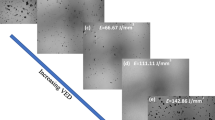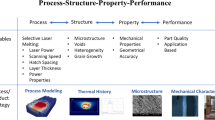Abstract
Laser powder bed fusion (L-PBF) technology is characterized by localized heat and repeated thermal cycles which result in distinct microstructures and induce residual stresses. Another crucial performance metric is tribological behaviour. In this study, the individual and combined influence of laser power, scanning speed and hatch spacing on the tribological behaviour and induced thermal stresses are explored. Using an X-ray diffraction technique, the residual stress was shown to have a direct correlation with the laser power and an inverse correlation with the hatch spacing. Also, residual stresses on the top planes (top residual stress, TRS) were relatively higher than stresses on the lateral surfaces (lateral residual stress, LRS). For the tribological performance, it was established that increase in power and reduction in the hatch spacing resulted in better tribological behaviour. However, the wear performance deteriorates when laser power reaches 250 W when using a hatch spacing of 80–100 µm.



















Similar content being viewed by others
Availability of data and material
The authors confirm that the supporting data in this journal is presented within the manuscripts itself and will make raw data presented in this study available upon request to the corresponding author [S. Boakye-Yiadom].
References
Pidge PA, Kumar H (2020) Additive manufacturing: a review on 3 D printing of metals and study of residual stress, buckling load capacity of strut members. Mater Today Proc 21:1689–1694
Conner BP et al (2014) Making sense of 3-D printing: creating a map of additive manufacturing products and services. Addit Manuf 1:64–76
Kruth J, Deckers J, Yasa E, Wauthlé R (2012) Assessing and comparing influencing factors of residual stresses in selective laser melting using a novel analysis method. Proc Inst Mech Eng Part B J Eng Manuf 226(6):980–991
Soni H, Gor M, Rajput GS, Sahlot P (2021) A comprehensive review on effect of process parameters and heat treatment on tensile strength of additively manufactured Inconel-625. Mater Today Proc 47:4866–4871
Fotovvati B, Balasubramanian M, Asadi E (2020) Modeling and optimization approaches of laser-based powder-bed fusion process for Ti-6Al-4V alloy. Coatings 10(11)
Withers PJ, Bhadeshia HKDH (2001) Residual stress part 2 - nature and origins. Mater Sci Technol 17(4):366–375
Li C, Liu ZY, Fang XY, Guo YB (2018) Residual stress in metal additive manufacturing. Procedia CIRP 71:348–353
Mercelis P, Kruth JP (2006) Residual stresses in selective laser sintering and selective laser melting. Rapid Prototyp J 12(5):254–265
Yan JJ et al (2017) Selective laser melting of H13: microstructure and residual stress. J Mater Sci 52(20):12476–12485
Lu Y et al (2015) Study on the microstructure, mechanical property and residual stress of SLM Inconel-718 alloy manufactured by differing island scanning strategy. Opt Laser Technol 75:197–206
Ali H, Ma L, Ghadbeigi H, Mumtaz K (2017) In-situ residual stress reduction, martensitic decomposition and mechanical properties enhancement through high temperature powder bed pre-heating of selective laser melted Ti6Al4V. Mater Sci Eng A 695(April):211–220
Xing LL, Zhang WJ, Zhao CC, Gao WQ, Shen ZJ, Liu W (2021) Influence of powder bed temperature on the microstructure and mechanical properties of Ti-6Al-4V alloys fabricated via laser powder bed fusion. Materials (Basel) 14(9)
Malỳ M et al (2019) Effect of process parameters and high-temperature preheating on residual stress and relative density of Ti6Al4V processed by selective laser melting. Materials (Basel) 16(6)
Moraes DADE (2018) Thermal Fe analysis of powder bed fusion process: power input evaluation and parameter sensitivity. York University
Yusuf SM, Chen Y, Yang S, Gao N (2020) Microstructural evolution and strengthening of selective laser melted 316L stainless steel processed by high-pressure torsion. Mater Charact 159(October 2019):110012
Quan J, Lin K, Gu D (2020) Selective laser melting of silver submicron powder modified 316L stainless steel: influence of silver addition on microstructures and performances. Powder Technol 364:478–483
Liao KH, Ou KL, Cheng HC, Lin CT, Peng PW (2010) Effect of silver on antibacterial properties of stainless steel. Appl Surf Sci 256(11):3642–3646
Okazaki Y, Gotoh E (2005) Comparison of metal release from various metallic biomaterials in vitro. Biomaterials 26(1):11–21
Sun Y, Moroz A, Alrbaey K (2014) Sliding wear characteristics and corrosion behaviour of selective laser melted 316L stainless steel. J Mater Eng Perform 23(2):518–526
Zhu Y, Zou J, Chen X, Yang H (2016) Tribology of selective laser melting processed parts: Stainless steel 316 L under lubricated conditions. Wear 350–351:46–55
Sander J, Hufenbach J, Giebeler L, Bleckmann M, Eckert J, Kühn U (2017) Microstructure, mechanical behavior, and wear properties of FeCrMoVC steel prepared by selective laser melting and casting. Scr Mater 126:41–44
Bartolomeu F et al (2017) 316L stainless steel mechanical and tribological behavior—a comparison between selective laser melting, hot pressing and conventional casting. Addit Manuf 16:81–89
Li H, Ramezani M, Li M, Ma C, Wang J (2018) Tribological performance of selective laser melted 316L stainless steel. Tribol Int 128(July):121–129
Yakout M, Elbestawi MA, Veldhuis SC (2019) Density and mechanical properties in selective laser melting of Invar 36 and stainless steel 316L. J Mater Process Technol 266 (October 2018):397–420
Miranda G et al (2016) Predictive models for physical and mechanical properties of 316L stainless steel produced by selective laser melting. Mater Sci Eng A 657:43–56
Eliasu A, Czekanski A, Boakye-Yiadom S (2021) Effect of laser powder bed fusion parameters on the microstructural evolution and hardness of 316L stainless steel. Int J Adv Manuf Technol 113(9–10):2651–2669
Eliasu A (2019) Microstructural and mechanical integrity of 3D printed 316L stainless steel. 17(4):73–78
Coeffi RF (2011) Standard test method for linearly reciprocating ball-on-flat sliding wear 1. Lubrication 05 (Reapproved 2010):1–10
Cho DH (2016) Determining the temperature field of selective laser melting. (August):62
Salem M, Le Roux S, Hor A, Dour G (2020) A new insight on the analysis of residual stresses related distortions in selective laser melting of Ti-6Al-4V using the improved bridge curvature method. Addit Manuf 36 (April):101586
Vandenbroucke B, Kruth JP (2007) Selective laser melting of biocompatible metals for rapid manufacturing of medical parts. Rapid Prototyp J 13(4):196–203
Vrancken B (2016) Study of residual stresses in selective laser melting. PhD Thesis; KU Leuven Arenb Dr Sch Fac Eng Sci (June):1–253
Liu Y, Yang Y, Wang D (2016) A study on the residual stress during selective laser melting (SLM) of metallic powder. Int J Adv Manuf Technol 87(1–4):647–656
Fotovvati B, Wayne SF, Lewis G, Asadi E (2018) A review on melt-pool characteristics in laser welding of metals. Adv Mater Sci Eng 2018:4920718
Mugwagwa L, Dimitrov D, Matope S, Yadroitsev I (2018) Influence of process parameters on residual stress related distortions in selective laser melting. Procedia Manuf 21 (2017):92–99
Bian P, Shi J, Liu Y, Xie Y (2020) Influence of laser power and scanning strategy on residual stress distribution in additively manufactured 316L steel. Opt Laser Technol 132 (July):106477
Wu AS, Brown DW, Kumar M, Gallegos GF, King WE (2014) An experimental investigation into additive manufacturing-induced residual stresses in 316L stainless steel. Metall Mater Trans A Phys Metall Mater Sci 45(13):6260–6270
Obidigbo C, Tatman EP, Gockel J (2019) Processing parameter and transient effects on melt pool geometry in additive manufacturing of Invar 36. Int J Adv Manuf Technol 104(5):3139–3146
Ramezani M, Wang J, Ma C, Li M, Li H (2018) Effect of process parameters on tribological performance of 316L stainless steel parts fabricated by selective laser melting. Manuf Lett 16:36–39
Donnell LJP (2010) Tribology of 316L austenitic stainless steel. Wear (January)
Blau PJ (2008) Friction science and technology: from concepts to applications, second edition
Boakye-Yiadom S, Bassim N (2012) Effect of heat treatment on stability of impact-induced adiabatic shear bands in 4340 steel. Mater Sci Eng A 546:223–232
Boakye-Yiadom S (2014) Microstructural evolution of adiabatic shear bands in steel by impact. University of Manitoba
Feaugas X, Haddou H (2003) Grain-size effects on tensile behavior of nickel and AISI 316L stainless steel. Metall Mater Trans A 34(10):2329–2340
Yasunaga K, Iseki M, Kiritani M (2003) Dislocation structures introduced by high-speed deformation in bcc metals. Mater Sci Eng A 350(1):76–80
Jarmakani H, McNaney JM, Kad B, Orlikowski D, Nguyen JH, Meyers MA (2007) Dynamic response of single crystalline copper subjected to quasi-isentropic, gas-gun driven loading. Mater Sci Eng A 463(1):249–262
McQueen HJ, Kassner ME (2004) Comments on ‘a model of continuous dynamic recrystallization’ proposed for aluminum. Scr Mater 51(5):461–465
Funding
This investigation is funded by the Natural Sciences and Engineering Research Council of Canada (NSERC).
Author information
Authors and Affiliations
Contributions
All authors were involved in the detailed analysis and discussions presented in this paper. A. Eliasu, S. H. Duntu, K. S. Hukpati1, M. Y. Amegadzie, J. Agyapong, F. Tetteh drafted the manuscript which was reviewed and edited by A. Czekanski and S. Boakye-Yiadom.
Corresponding author
Ethics declarations
Ethical approval
Not applicable.
Consent to participate and publish
The authors are pleased to submit this full-length research for review and possible publication. This submission is original and is not being submitted for publication elsewhere.
Conflict of interest
The authors declare that they have no known competing financial interests or personal relationships that could have influenced the work reported in this paper.
Additional information
Publisher's Note
Springer Nature remains neutral with regard to jurisdictional claims in published maps and institutional affiliations.
Rights and permissions
About this article
Cite this article
Eliasu, A., Duntu, S.H., Hukpati, K.S. et al. Effect of individual printing parameters on residual stress and tribological behaviour of 316L stainless steel fabricated with laser powder bed fusion (L-PBF). Int J Adv Manuf Technol 119, 7041–7061 (2022). https://doi.org/10.1007/s00170-021-08489-y
Received:
Accepted:
Published:
Issue Date:
DOI: https://doi.org/10.1007/s00170-021-08489-y




